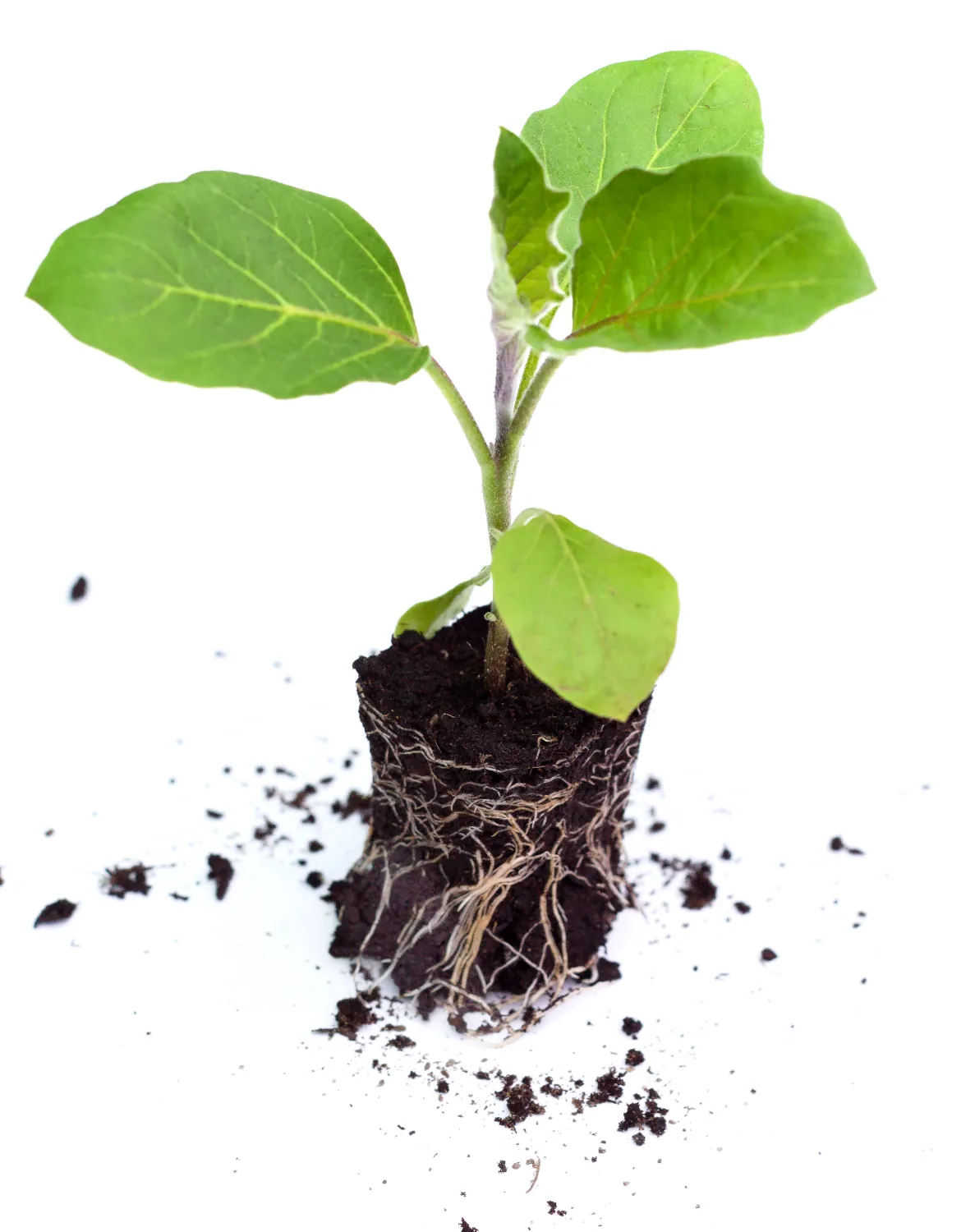If you have run out of plants to grow in hydroponics, let’s learn how to grow hydroponic eggplants. It won’t be as difficult as growing hydroponic potatoes or onions.
To make a short comparison, it’s more on the level of growing cucumbers hydroponically.
If you’re a complete beginner, turn towards lettuce and herbs, first. There are plenty to have fun with and learn from.
Table of Contents
Eggplant vs Aubergine
Before going into the wonderful conditions you need to achieve if you want to know how to grow hydroponic eggplants, let’s define something.
Eggplants can also be called aubergines. They’re the same thing, aubergine is the name used by Europeans. You’ve guessed it, it’s French and it definitely sounds good.
As this article tells us, Americans call it eggplant because the original aubergines brought by immigrants looked like white eggs. That was actually a white brinjal, which is used in Indian cooking.
We mostly grow the variety with larger longer purple fruit. Some people absolutely love it, while others not so much.
Japanese cuisine has actually some of the most delicious eggplant dishes. When you harvest your first eggplants, after learning how to grow hydroponic eggplants and succeeding, I suggest checking out some Japanese recipes.
Italians are not bad with them, either.
Some of the most popular eggplant varieties are:
- Black King
- Globe/American
- Chinese
- Graffiti/Zebra/Sicilian
- Japanese
- Little Green – it has indeed a neongreen skin and grows smaller than other varieties, very interesting
- Rosa Bianca
- Fairy Tale Eggplant – one of the most beautiful varieties, a bit smaller than the rest but very sweet and delicious
How to Grow Hydroponic Eggplants: Conditions

The main conditions for getting a good yield from hydroponic eggplants revolve around pretty high temperatures, high humidity (60-70%), and a growing medium with sufficient depth for eggplants to develop their expansive root system.
They love their hot temperatures so much that in hot countries eggplant is actually grown as a perennial.
Another thing this crop requires is patience because it’s not the fastest to reach harvesting stage.
Otherwise, these plants are not really demanding, even when it comes to how much light they receive.
1. pH & EC
The recommended pH is 5.0 to 7.0. That’s quite the wide range so, there’s not a lot of monitoring to be done in this area.
Fruiting crops require an EC between 2.0 and 3.5.
For the vegetative stage, you can have an EC between 1.8 and 2.4 and for the fruiting stage it can be between 2.6 and 3.0.
2. Temperature
These plants love their warmth, pretty much the same as cucumbers do.
Grow them at temperatures of 72-85 degrees F (22-29 degrees C) during the day and 60-65 degrees F (15-18 degrees C) at night. You shouldn’t let night temperatures fall below 60°F.
3. Do you need to use a circulatory fan for this crop?
It can be a nice addition for leveling temperature, humidity and carbon dioxide indoors.
Moreover, it can help with pollination.
4. Grow lights
This is the area where I have good news.
Outdoors, these plants love full sun.
For those growing indoors, you should know that eggplants are neutral when it comes to how much light they need to receive. They’re neither long-day plants nor short-day plants.
That means that you can grow them together with other crops that require either more light or less light. They will do well with both.
So, as a suggestion, you can let the grow lights on for 8 to 10 hours per day.
If your artificial lights don’t come with a timer, you can get one. You won’t have to switch them on and off manually.
5. Nutrient solution
Household growers should focus on two options: buying a general nutrient solution for hydroponics or making their own, if they want to save more money.
You can make your own from NPK fertilizer with macro-nutrients (copper, cobalt, boron, iron, zinc), calcium nitrate, and epsom salt (magnesium sulfate). The ingredients are easy to find. The ratios are 1 unit NPK fertilizer + 1 unit calcium nitrate + half a unit epsom salt.
If you go with the manufactured option, you should also be aware that there are nutrient products for the two main stages: vegetative and bloom.
Fruiting crops, like the subject we’re discussing, go through the following stages: vegetative-only, flowering and fruit set, and fruit development phase.
Commercial growers will use different nutrients of different strengths for each of these 3 stages. But that would be just too difficult for us.
As all the other fruiting crops, they require high nitrogen and potassium content.
6. Pollination
Gently shake the stem of your plant daily at flowering time.
If you have a fan nearby, it will do the work for you by moving the pollen grains and increasing the odds of pollination.
Hydroponic Eggplant Propagation
There are actually two methods for eggplant propagation for hydroponics.
From Seeds

Germination from seed is completed in 8 to 10 days at temperatures of 77 to 86 degrees Fahrenheit (25 to 30 degrees C). Take the dome off when the seedlings appear.
You can transplant the seedlings with the rockwool cubes into the hydroponic system when they have 4 to 5 true leaves. That can take as much 6 to 8 weeks.
That’s when you can also start using nutrient solution.
It’s best to give them space. If you’re using grow beds or rafts, plant 3-5 plants per 1 square meter (10 square feet).
Eggplants grow quite big. They can reach 1 to 3 feet 3 to 8 feet in height and 1 to 3 feet. The same as cucumbers.
You don’t have to worry about spacing if you’re using 5 gallon buckets to grow them because each bucket will grow one plant.
From Cuttings
If you want to skip a few steps and make things easier, you can consider propagation of eggplants from cuttings. It works just like it does for basil or peppers, for example.
Fill a jar 2/3 full with water and place 2,3 cuttings in each jar. Place the jar on the window sill and change the water once every few days.
The cuttings should grow roots in about 2-3 weeks. At this point, you can insert them in the growing medium in the system.
Best Systems for Hydroponic Eggplants

If you’re experienced with hydroponics, you pretty much understand that in order to grow hydroponic eggplants, you need systems that are designed for growing large plants.
Some of the best for these kinds of crops are the drip hydroponic system and the ebb and flow system.
So, if you want to know how to grow hydroponic eggplants in large quantities, the focus should be on systems like these.
They’re pretty hard to build but you could focus on the drip with 5 gallon buckets, it’s one of the most accessible for households.
You’ll plant one eggplant per each bucket. The advantage is that you can link as many buckets as you want.
For the ebb and flow, you need a grow bed. Hydroponic grow trays can be quite expensive, depending on how big you want them to be.
With these systems, as growing medium, you can use coco coir, rockwool, peat moss.
Easy to Build Systems for Growing Eggplants Hydroponically
When it comes to knowing how to grow hydroponic eggplants in easy-to-build systems then the answer always comes back to making a DWC system.
You can set these systems at a height and let the plant hang over as it continues to grow.
Storage tote DWC system
You can make one using a storage plastic tot as a container and grow the plant in the plastic lid. You put holes through the lid, big enough to fit 3-inch net pots.
The net pots are filled with hydroton (expanded clay aggregate). The hydroton will be all around the rockwool cubes, which contain the seedlings.
So, the roots will float down in the water and they will take as much nutrients as they need.
In order to keep the water oxygenated, an air pump and an air stone are used. The air stone is placed inside the container.
You can do the same by using an old aquarium tank and using a polystyrene raft.
The advantage is that no water pump or timer is needed for these kinds of basic systems. It’s less technical than an ebb and flow or a drip.
5 gallon bucket DWC system
The most basic set-up involves using a 5 gallon bucket where you place the water pump at the bottom. The lid is where the net pot with the growing medium is placed.
If you want to take it one step further, you’ll create a system that links as many buckets as you want.
How to Grow Hydroponic Eggplants in AeroGarden
On their website, they actually have a guide for growing eggplants in their indoor garden hydroponic system. You can take their advice and apply it to the model that you’re owning, be it from iDoo or Ezorkas or other of the kind.
AeroGarden has created their Fairy Tale Eggplant Seed Pod Kit.
This variety looks absolutely beautiful with its light purple and white streaks. And the fruits are smaller, which makes it perfect for these small machines.
The alternative it to buy seeds for the variety you wish to grow and place 1-2 seeds in grow sponges. Or you can buy the seed pod kit and use it on other models, even if they’re from different manufacturers.
They recommend putting no more than 3 grow sponges in the pods because these are big plants and they need their space. You can cover the remaining holes with spacers.
They also recommend to pollinate the plant by simple shaking the stem gently or by pointing a fan at the plants.
The problem is with the large leaves, which can block the light from reaching the understory of the plant.
AeroGarden advises us to remove the big leaves that block absolutely all the light. I definitely agree. It’s a necessary pruning, otherwise we would end up with stunted growth and fruit not forming.
It’s recommended to harvest them when they are between 3-4 inches long and have bright shiny skins.
If you wanted to know how to grow hydroponic eggplants for complete beginners, then this is it. It doesn’t get much easier than using a small but effective indoor garden hydroponic kit.
Harvesting
The fruits will start appearing after 80-90 days.
It takes quite a while until eggplants grown hydroponically reach the harvesting stage. It can take between 90 to 120 days.
You can harvest when they are 4 to 6 inches long (10 to 15 cm). The skin must be shiny. When it becomes dull and yellow, the eggplant is too ripe.
When you remove the fruit from the plant, use a knife to cut it and leave at least 1 inch (3 cm) of stem attached to the fruit.
The awesome news is that a plant can produce 10 to 15 fruits as total yield, which is achievable if you have understood how to grow hydroponic eggplants under the right conditions.




